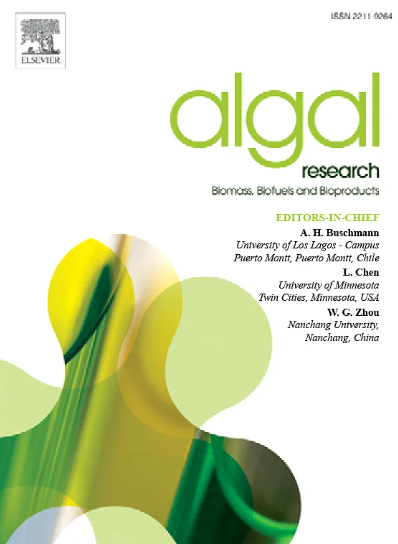cladophora基磁性纳米复合材料用于环保废水处理:去除染料和油
IF 4.5
2区 生物学
Q1 BIOTECHNOLOGY & APPLIED MICROBIOLOGY
Algal Research-Biomass Biofuels and Bioproducts
Pub Date : 2025-05-20
DOI:10.1016/j.algal.2025.104107
引用次数: 0
摘要
对清洁水的需求日益增加,染料和石油泄漏造成的持续污染需要开发高效环保的修复技术。在本研究中,合成了从藻中提取的生物基磁性纳米复合材料,并将其应用于去除水溶液中的有机污染物。合成的材料Cladophora@CoFe和Cladophora@CoFe-DA被开发为可持续吸附剂,利用Cladophora藻类丰富的可再生生物量,为水净化提供了一种经济高效的绿色方法。通过评价纳米复合材料在优化条件下对染料和油类污染物的去除效果,系统研究了纳米复合材料的吸附行为。Cladophora@CoFe纳米复合材料对亚甲基蓝染料的去除率超过86.1%,最大吸附量为64.5 mg g−1。同时,Cladophora@CoFe-DA由于其疏水性增强,表现出良好的吸油性能,这是由于癸酸的功能化。利用FTIR、PXRD、FESEM、EDX、MAP、VSM和TGA对合成的纳米复合材料进行了全面表征,确定了其结构和磁性能。此外,通过在真实水样中的吸附测试验证了这些纳米复合材料的实际适用性,增强了它们在大规模废水处理应用中的潜力。这些仿生纳米复合材料为去除有机污染物提供了一种可持续、高效、易于回收的解决方案,使其非常适合工业和环境应用。本文章由计算机程序翻译,如有差异,请以英文原文为准。

Cladophora-based magnetic nanocomposites for eco-friendly wastewater treatment: Removal of dyes and oil
The increasing demand for clean water and the continuous contamination caused by dyes and oil spills necessitate the development of efficient and eco-friendly remediation technologies. In this study, bio-based magnetic nanocomposites derived from Cladophora algae were synthesized and applied for the removal of organic pollutants from aqueous solutions. The synthesized materials, Cladophora@CoFe and Cladophora@CoFe-DA, were developed as sustainable adsorbents, leveraging the abundant and renewable biomass of Cladophora algae to provide a cost-effective and green approach to water purification. The adsorption behavior of these nanocomposites was systematically investigated by evaluating their efficiency in removing dye and oil pollutants under optimized conditions. The Cladophora@CoFe nanocomposite exhibited remarkable efficiency in removing methylene blue dye, achieving a removal rate exceeding 86.1 %, with a maximum adsorption capacity of 64.5 mg g−1. Meanwhile, Cladophora@CoFe-DA exhibited outstanding oil absorption due to its enhanced hydrophobicity, attributed to decanoic acid functionalization. The synthesized nanocomposites were thoroughly characterized using FTIR, PXRD, FESEM, EDX, MAP, VSM, and TGA, confirming their structural and magnetic properties. Furthermore, the practical applicability of these nanocomposites was validated through adsorption tests in real water samples, reinforcing their potential for large-scale wastewater treatment applications. These bio-inspired nanocomposites provide a sustainable, efficient, and easily recoverable solution for removing organic pollutants, making them highly suitable for industrial and environmental applications.
求助全文
通过发布文献求助,成功后即可免费获取论文全文。
去求助
来源期刊

Algal Research-Biomass Biofuels and Bioproducts
BIOTECHNOLOGY & APPLIED MICROBIOLOGY-
CiteScore
9.40
自引率
7.80%
发文量
332
期刊介绍:
Algal Research is an international phycology journal covering all areas of emerging technologies in algae biology, biomass production, cultivation, harvesting, extraction, bioproducts, biorefinery, engineering, and econometrics. Algae is defined to include cyanobacteria, microalgae, and protists and symbionts of interest in biotechnology. The journal publishes original research and reviews for the following scope: algal biology, including but not exclusive to: phylogeny, biodiversity, molecular traits, metabolic regulation, and genetic engineering, algal cultivation, e.g. phototrophic systems, heterotrophic systems, and mixotrophic systems, algal harvesting and extraction systems, biotechnology to convert algal biomass and components into biofuels and bioproducts, e.g., nutraceuticals, pharmaceuticals, animal feed, plastics, etc. algal products and their economic assessment
 求助内容:
求助内容: 应助结果提醒方式:
应助结果提醒方式:


